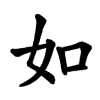Definify.com
Definition 2025
肉
肉
| ||||||
|---|---|---|---|---|---|---|
Translingual
| Stroke order | |||
|---|---|---|---|

| |||
Alternative forms
- ⺼ U+2EBC (when used as a left Chinese radical in compositions)
The radical form ⺼ looks very similar to 月 (“moon”), and is often drawn identically in compounds, though they are etymologically distinct, and careful usage distinguishes the cross strokes, with ⺼ written with unattached diagonal strokes. This is particularly an issue in looking up characters by radical; compare 月 index and 肉 index.
The radical form ⺼ may also appear twisted to a diagonal, resembling 夕 with an added dot, as in 祭, 然, and 將.
Han character
肉 (radical 130 肉+0, 6 strokes, cangjie input 人月人 (OBO), four-corner 40227)
- Kangxi radical #130, ⾁ (“meat”).
Derived characters
References
- KangXi: page 973, character 1
- Dai Kanwa Jiten: character 29236
- Dae Jaweon: page 1424, character 4
- Hanyu Da Zidian: volume 5, page 2931, character 1
- Unihan data for U+8089
Chinese
|
simp. and trad. |
肉 | |
|---|---|---|
Glyph origin
| Historical forms of the character 肉
| |||
|---|---|---|---|
| Oracle bone script | Bronze inscriptions | Large seal script | Small seal script |
 |
 |
 |
 |
| Characters in the same phonetic series (肉) (Zhengzhang, 2003) | |
|---|---|
| Old Chinese | |
| 朒 | *nuɡ |
| 肉 | *njuɡ |
Pictogram (象形) – ribs of an animal’s torso.
Etymology 1
From Proto-Sino-Tibetan *s-nja-k (“meat, flesh”).
Pronunciation
- Mandarin
- Cantonese (Jyutping): juk6
- Hakka (Sixian, PFS): ngiuk
- Min Dong (BUC): nṳ̆k
- Min Nan
- Wu (Wiktionary): nyoq (T5)
- Mandarin
- (Standard Chinese, Beijing)+
- Pinyin:
- Zhuyin: ㄖㄡˋ
- Wade-Giles: jou4
- Gwoyeu Romatzyh: row
- IPA (key): /ʐoʊ̯⁵¹/
-

- (Standard Chinese, Beijing)+
- Cantonese
- (Standard Cantonese, Guangzhou)+
- Jyutping: juk6
- Yale: yuhk
- Cantonese Pinyin: juk9
- IPA (key): /jʊk̚²/
- (Standard Cantonese, Guangzhou)+
- Hakka
- (Sixian, incl. Miaoli and Meinong)
- Pha̍k-fa-sṳ: ngiuk
- Hakka Romanization System: ngiug`
- Hagfa Pinyim: ngiug5
- IPA: /ɲi̯uk̚²/
- (Sixian, incl. Miaoli and Meinong)
- Min Dong
- (Fuzhou)
- Bàng-uâ-cê: nṳ̆k
- IPA (key): /nˡyʔ⁵⁵/
- (Fuzhou)
- Min Nan
- (Hokkien: Zhangzhou, Kaohsiung)
- Pe̍h-ōe-jī: jio̍k
- Tâi-lô: jio̍k
- Phofsit Daibuun: jiok
- IPA (Zhangzhou): /d͡ʑiɔk̚¹²¹/
- IPA (Kaohsiung): /d͡ʑiɔk̚⁴/
- (Hokkien: Xiamen, Quanzhou, Taipei)
- Pe̍h-ōe-jī: lio̍k
- Tâi-lô: lio̍k
- Phofsit Daibuun: liok
- IPA (Xiamen): /liɔk̚⁴/
- IPA (Quanzhou): /liɔk̚²⁴/
- IPA (Taipei): /liɔk̚⁴/
- (Hokkien: Xiamen, Taipei, Kaohsiung)
- Pe̍h-ōe-jī: he̍k
- Tâi-lô: hi̍k
- Phofsit Daibuun: hek
- IPA (Xiamen): /hiɪk̚⁴/
- IPA (Taipei): /hiɪk̚⁴/
- IPA (Kaohsiung): /hiɪk̚⁴/
- (Hokkien: Quanzhou)
- Pe̍h-ōe-jī: hia̍k
- Tâi-lô: hia̍k
- Phofsit Daibuun: hiak
- IPA (Quanzhou): /hiak̚²⁴/
- Note: jio̍k, lio̍k - literary; he̍k, hia̍k - vernacular.
- (Teochew)
- Peng'im: nêg8
- Pe̍h-ōe-jī-like: ne̍k
- IPA (key): /nek̚⁴/
- (Hokkien: Zhangzhou, Kaohsiung)
- Wu
- (Shanghainese)
- Wiktionary: nyoq (T5)
- IPA (key): /ȵʊʔ¹²/
- (Shanghainese)
- Dialectal data▼
| Variety | Location | 肉 |
|---|---|---|
| Mandarin | Beijing | /ʐou⁵¹/ |
| Harbin | /ʐou⁵³/ | |
| Tianjin |
/iou⁵³/ /ʐou⁵³/ |
|
| Jinan | /ʐou²¹/ | |
| Qingdao | /iou⁴²/ | |
| Zhengzhou | /ʐou³¹²/ | |
| Xi'an | /ʐou⁴⁴/ | |
| Xining | /ʐɯ²¹³/ | |
| Yinchuan | /ʐəu¹³/ | |
| Lanzhou | /ʐou¹³/ | |
| Ürümqi | /ʐɤu²¹³/ | |
| Wuhan | /nəu²¹³/ | |
| Chengdu |
/zu³¹/ /zəu¹³/ |
|
| Guiyang | /zu²¹/ | |
| Kunming |
/ʐəu²¹²/ /ʐu³¹/ |
|
| Nanjing | /ʐəɯ⁴⁴/ | |
| Hefei | /ʐɯ⁵³/ | |
| Jin | Taiyuan |
/zəu⁴⁵/ 豬~ /zuəʔ²/ ~桂 |
| Pingyao | /ʐəu³⁵/ | |
| Hohhot | /ʐəu⁵⁵/ | |
| Wu | Shanghai | /ȵioʔ¹/ |
| Suzhou | /ȵioʔ³/ | |
| Hangzhou | /zoʔ²/ | |
| Wenzhou | /ȵɤu²¹³/ | |
| Hui | Shexian | /niu²²/ |
| Tunxi | /ȵiu¹¹/ | |
| Xiang | Changsha | /ʐəu²⁴/ |
| Xiangtan | /iəɯ²⁴/ | |
| Gan | Nanchang | /ȵiuʔ⁵/ |
| Hakka | Meixian | /ŋiuk̚¹/ |
| Taoyuan | /ŋiuk̚²²/ | |
| Cantonese | Guangzhou | /jok̚²/ |
| Nanning | /juk̚²²/ | |
| Hong Kong | /juk̚²/ | |
| Min | Xiamen (Min Nan) |
/liɔk̚⁵/ /hik̚⁵/ |
| Fuzhou (Min Dong) | /nyʔ⁵/ | |
| Jian'ou (Min Bei) | /ny⁴²/ | |
| Shantou (Min Nan) | /nek̚⁵/ | |
| Haikou (Min Nan) | /hiɔk̚³/ |
| Rime | |
|---|---|
| Character | 肉 |
| Reading # | 1/1 |
| Initial (聲) | 日 (38) |
| Final (韻) | 屋 (4) |
| Tone (調) | Checked (Ø) |
| Openness (開合) | Open |
| Division (等) | III |
| Fanqie | 如六切 |
| Reconstructions | |
| Zhengzhang Shangfang |
/ȵɨuk̚/ |
| Pan Wuyun |
/ȵiuk̚/ |
| Shao Rongfen |
/ȵʑiuk̚/ |
| Edwin Pulleyblank |
/ȵuwk̚/ |
| Li Rong |
/ȵiuk̚/ |
| Wang Li |
/ȵʑĭuk̚/ |
| Bernard Karlgren |
/ȵʑi̯uk̚/ |
| Expected Mandarin Reflex |
rù |
| Baxter-Sagart system 1.1 (2014) | |
|---|---|
| Character | 肉 |
| Reading # | 1/1 |
| Modern Beijing (Pinyin) |
ròu |
| Middle Chinese |
‹ nyuwk › |
| Old Chinese |
/*k.nuk/ |
| English | meat, flesh |
Notes for Old Chinese notations in the Baxter-Sagart system: * Parentheses "()" indicate uncertain presence; | |
| Zhengzhang system (2003) | |
|---|---|
| Character | 肉 |
| Reading # | 1/1 |
| No. | 10866 |
| Phonetic component |
肉 |
| Rime group |
覺 |
| Rime subdivision |
1 |
| Corresponding MC rime |
肉 |
| Old Chinese |
/*njuɡ/ |
Definitions
肉
- meat; flesh
-
- 這種魚的肉異常鮮美。 [MSC, trad.]
- 这种鱼的肉异常鲜美。 [MSC, simp.]
- Zhè zhǒng yú de ròu yìcháng xiānměi. [Pinyin]
- The flesh of this kind of fish has exceptional delicacy.
-
- 他們可以飽餐一頓這些死動物的肉。 [MSC, trad.]
- 他们可以饱餐一顿这些死动物的肉。 [MSC, simp.]
- Tāmen kěyǐ bǎocānyīdùn zhèxiē sǐ dòngwù de ròu. [Pinyin]
- They could feast on the flesh of the dead animals.
-
- body
- flesh; pulp
- (dialectal) spongy; squashy; flabby
- (dialectal) slow; sluggish
Compounds
|
|
|
Descendants
Etymology 2
|
simp. and trad. |
肉 | |
|---|---|---|
| alt. forms | 脈/脉 | |
Possibly of substrate origin, perhaps from Proto-Austronesian *babuy (“wild pig”) (see baboy). Alternatively, it may be related to 脢.
Pronunciation
- Min Nan
- (Hokkien: Xiamen, Quanzhou, Zhangzhou, mainstream Taiwanese)
- Pe̍h-ōe-jī: bah
- Tâi-lô: bah
- Phofsit Daibuun: baq
- IPA (Xiamen): /baʔ³²/
- IPA (Quanzhou): /baʔ⁵/
- IPA (Zhangzhou): /baʔ³²/
- IPA (Taipei): /baʔ³²/
- IPA (Kaohsiung): /baʔ³²/
- (Hokkien: Quanzhou)
- Pe̍h-ōe-jī: mah
- Tâi-lô: mah
- Phofsit Daibuun: maq
- IPA (Quanzhou): /maʔ⁵/
- (Teochew)
- Peng'im: bhah4
- Pe̍h-ōe-jī-like: bah
- IPA (key): /baʔ²/
- Note: chiefly overseas.
- (Hokkien: Xiamen, Quanzhou, Zhangzhou, mainstream Taiwanese)
Definitions
肉 (Min Nan)
- meat; flesh
- 豬肉 / 猪肉 [Min Nan] ― ti-bah [Pe̍h-ōe-jī] ― pork
- 牛肉 [Min Nan] ― gû-bah [Pe̍h-ōe-jī] ― beef
- pork
- 肉骨 [Min Nan] ― bah-kut [Pe̍h-ōe-jī] ― pork ribs
- flesh; pulp
- 龍眼乾肉 / 龙眼干肉 [Min Nan] ― lêng-géng-koaⁿ bah [Pe̍h-ōe-jī] ― flesh of dried longan
- main part of an object
- 刀肉 [Min Nan] ― to-bah [Pe̍h-ōe-jī] ― blade of a knife or sword
References
- “Entry #2607”, in 臺灣閩南語常用詞辭典 [Dictionary of Frequently-Used Taiwan Minnan] (in Chinese and Min Nan), Ministry of Education, R.O.C., 2011.
Japanese
Kanji
Readings
Etymology 1
| Kanji in this term |
|---|
| 肉 |
|
しし Grade: 2 |
| kun'yomi |
From Old Japanese. Not used in isolation in modern Japanese. Persists in compounds.
Cognate with 獣 (shishi, “beast, especially one used for meat”).
Pronunciation
Noun
肉 (hiragana しし, romaji shishi)
Derived terms
|
Etymology 2
| Kanji in this term |
|---|
| 肉 |
|
にく Grade: 2 |
| on'yomi |
From Middle Chinese 肉 (*njiuk). Compare modern Min Nan 肉 (jiok8) or Hakka 肉 (niuk7).
Pronunciation
Noun
- meat, the muscle and fat tissue of an animal used as food
- the flesh of an animal
- the flesh of a fruit or vegetable
- one's body, as opposed to spirit
- the thickness of a thing
- 板の肉
- ita no niku
- the thickness of a board
- 板の肉
- (figuratively) the flesh or meat of something, such as an idea, structure, or argument
- 議論に肉をつける
- giron ni niku o tsukeru
- to put some meat on an argument, to flesh out an argument
- 議論に肉をつける
- an ink pad, a stamp pad
- (theater, kabuki) short for 肉襦袢 (niku juban): flesh-toned undergarments worn by actors and shown when the character has to display their skin
Synonyms
- (fruit or vegetable flesh): 実 (mi)
- (body): 肉体 (nikutai)
- (thickness): 厚さ (atsusa), 太さ (futosa)
- (ink pad): 印肉 (inniku)